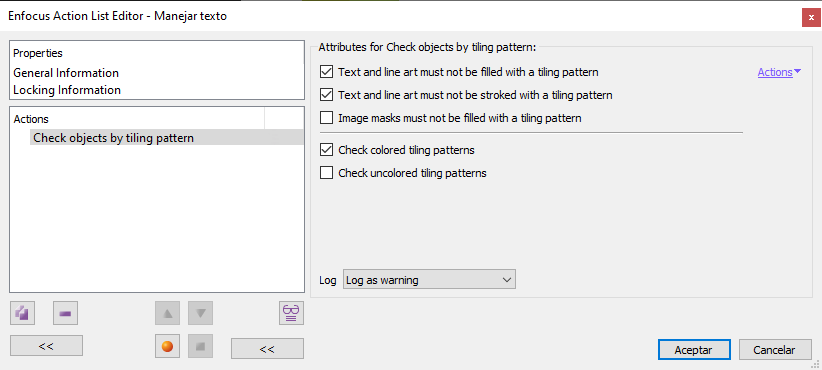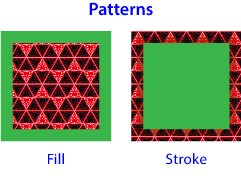
This Enfocus PitStop command allows us to check the existence of different types of tiles in the selected objects. If the selected conditions are met, the PDF will be marked as chosen in the "Log" area for further processing.
The five available options are not mutually excluding and can be selected wholly or in part. The first three options indicate the kind of use of patterns that a PDF should not contain. If any of them is found, PitStop will warn us and "log" them:
-
"
Text and line art must not be filled with a tiling pattern". If this condition is checked, the presence of objects that use a vector mosaic as a fill colour will be marked (as error or warning). -
"
Text and line art must not be stroked with a tiling pattern". If this condition is checked, the presence of objects that use a vector mosaic as a stroke colour will be marked (as error or warning). -
"
Image masks must not be filled with a tiling pattern". If this condition is checked, the presence of image masks that use a vector mosaic as a fill.
The two last options tell PitStop to check for patterns. If we don't check any of them, the program won't actually check anything.
-
"
Check colored tiling patterns". With this option, PitStop will check the presence of colour patterns (that is, the definitions of the tile colours are inside the pattern definition). They are most common type of patterns. -
"
Check uncolored tiling patterns". With this option, PitStop will check the presence of patterns in which the colour assignment (coloring) goes in a final instruction that is only executed at rendering time. This is a variant of patterns defined in the PDF format less common than the one above.

As an example to understand its use: If we have a PDF like the one above, originally made in Illustrator, in which there are vector shapes or texts filled with patterns, PitStop will only detect their presence if we check the options first (the fill is a mosaic ), second (the outline is a mosaic) and fourth (patterns with defined colours are used).
Warning: Sometimes the presence of vector patterns can cause problems at printing time or in the handling of documents because their complexity overloads the system. Checking them allows their subsequent treatment to, for example, rasterize them, which simplifies the documents.
[© Gustavo Sánchez Muñoz, 2025] Gustavo Sánchez Muñoz (also identified as Gusgsm) is the author of the content of this page. Its graphic and written content can be shared, copied and redistributed in whole or in part without the express permission of its author with the only condition that it cannot be used for directly commercial purposes (that is: It cannot be resold, but it can form part as reasonable quotations in commercial works) and the legal terms of any derivative works must be the same as those expressed in this statement. The citation of the source with reference to this site and its author is not mandatory, although it is always appreciated.